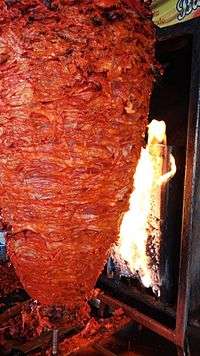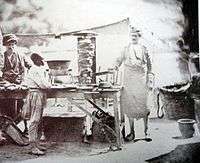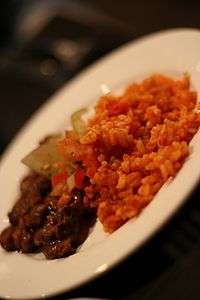Al pastor
 A "trompo" of pastor meat | |
| Place of origin | Mexico |
|---|---|
| Serving temperature | Warm |
| Main ingredients | Pork meat |
Al pastor (from Spanish, "shepherd style"), also known as tacos al pastor, is a dish developed in central Mexico that is based on shawarma spit-grilled meat brought by Lebanese immigrants to Mexico.[1] Being derived from shawarma, it is also similar to the Turkish döner kebab and the Greek gyros. In contrast to döner kebab and shawarma however, tacos al pastor are pork based. In some places of northern Mexico, as in Baja California, this taco is called taco de adobada. A similar dish from Puebla with different spices is tacos árabes.[2]
History

A wave of mainly Christian Lebanese immigration to Mexico took place in the late 19th and early 20th centuries. In the 1960s, Mexican-born progeny of Lebanese immigrants began opening their own restaurants and combining their heritage with Mexican cuisine.[3]
Grilling a vertical spit of stacked meat slices and cutting it off as it cooks was developed in the 19th century in Ottoman Turkey.[4][5] This is döner kebab, which is the origin of tacos al pastor, Middle Eastern shawarma, and Greek gyros.
Preparation
Pork is marinated in a combination of dried chilies, spices and pineapple. In some places, achiote is also added, and then slowly cooked with a gas flame on a vertical rotisserie called a trompo (lit: spinning top), very similar to how shawarma is cooked, with a piece of fresh onion and a pineapple on top.[6] When ready, the meat is then thinly sliced off the spit with a large knife. It is served on small tortillas, with finely chopped onions, cilantro, and occasionally a small slice of pineapple, and usually topped with some lemon or lime juice and hot salsa. This meat is a common ingredient in not just tacos, but also gringas, alambres, huaraches, tortas, burritos and pizza.

Varieties
In some places of northern Mexico, such as Nuevo León, Durango and Chihuahua, these are usually called tacos de trompo if served on corn tortillas, and gringas if they are served with cheese on wheat tortillas.
A similar dish is called tacos árabes, which originated in Puebla in the 1930s from Arab Mexican cuisine. Tacos árabes use shawarma-style meat carved from a spit, but are served in a pita-style bread called pan árabe. These tacos have been brought by Mexican immigrants to the United States in the past few years and have become popular in cities, such as Chicago and Los Angeles, two of the largest Mexican/Mexican-American population centers in the United States.[7]
A non-pork version featuring chicken marinated in the "al pastor" style was brought "back" to the Middle East in the early 2000s, and sold as "shawarma mexici". It is essentially a chicken shawarma made in the Middle Eastern style (wrapped with garlic mayonnaise, dill pickle, and french fries in a thin flatbread).
See also
References
- ↑ David Sterling, "The Lebanese Connection," Yucatan: A Culinary Expedition. http://www.los-dos.com/culinary-expedition/verarticulo.php?IdArticulo=258
- ↑ Peterson, Lucas (26 March 2015). "These Massive Tacos Árabes in Boyle Heights Pack a Punch". Eater.com LA. Retrieved 2018-03-10.
- ↑ "Thank the Ottoman Empire for the taco al pastor". Retrieved 8 August 2017.
- ↑ Eberhard Seidel-Pielen (May 10, 1996). "Döner-Fieber sogar in Hoyerswerda" [Doner fever even in Hoyerswerda]. ZEIT ONLINE (in German). Retrieved May 6, 2016.
- ↑ Kenneth F. Kiple, Kriemhild Coneè Ornelas, eds., Cambridge World History of Food, Cambridge, 2000. ISBN 0-521-40216-6. Vol. 2, p. 1147
- ↑ "Wrap It Up: A Guide To Mexican Street Tacos - Part 2: Nighttime Tacos : Mexico Cuisine".
- ↑ David Hammond, "Perfection on a Spit," Chicago Reader, November 8, 2007.http://www.chicagoreader.com/features/stories/restaurants/071108/


.jpg)



